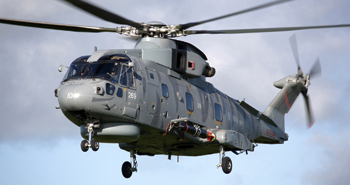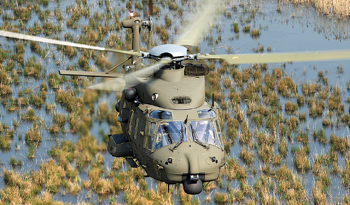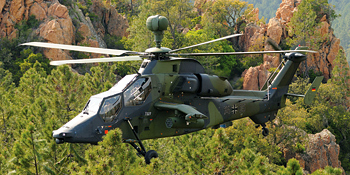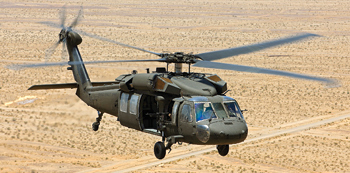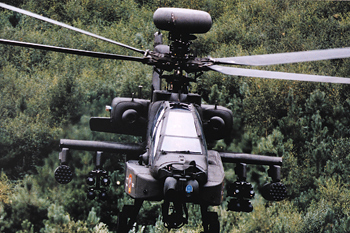INDIAN ARMED FORCES CHIEFS ON
OUR RELENTLESS AND FOCUSED PUBLISHING EFFORTS

SP Guide Publications puts forth a well compiled articulation of issues, pursuits and accomplishments of the Indian Army, over the years

I am confident that SP Guide Publications would continue to inform, inspire and influence.

My compliments to SP Guide Publications for informative and credible reportage on contemporary aerospace issues over the past six decades.
- Prime Minister witnesses 'Bharat Shakti' – a Tri-Services Firing and Manoeuvre Exercise in Pokhran, Rajasthan
- Interim Defence Budget 2024-25 — An Analysis
- Union Defence budget 2024
- Prime Minister Modi Commemorates Indian Navy Day in a Grand Ceremony
- Prime Minister Modi Flies in the LCA Tejas
- New Chapter in India-Italy Defence Ties
- Airpower beyond Boundaries
Military helicopters dominate market
Military helicopters have played critical roles in many a combat situation worldwide. And when in 2011 the celebrated US Navy SEALs team (ST6) undertook one of the most covert special operations mission, to eliminate terrorist Osama bin Laden, it was the ‘stealth’ helicopter that gave the ST6 a decisive advantage. The Sikorsky MH60 (K/M version) highlighted ‘stealth’ among other roles.
Helicopters have come a long way from the most common use of military – transportation of troops. They have been modified or converted to perform missions such as combat search and rescue (CSAR), airborne command post, attack, etc. Stealth combined with lethality is at recent feature, responding to the varied needs of the military.
The military helicopter market is growing rapidly and Frost & Sullivan predicts that military will account for more than 60 per cent of the global helicopter demand over the next 10 years (in terms of market value), generating revenues of nearly $200 billion, and creating orders of nearly 9,000 platforms between 2011 and 2020. This demand for military helicopters is driven not only by a desire to obtain new, modern helicopters but mostly by the need to replace/upgrade a large global fleet of ageing helicopters.
Global players
The military helicopter industry is dominated by major Western European manufacturers such as AgustaWestland and Eurocopter group; the three large US companies—Boeing, Bell Helicopter and Sikorsky Aircraft; and Russian Helicopters. They fall in Tier-1 category of global players. In the Tier-II category are regional players with global aspirations and the companies include India’s Hindustan Aeronautics Limited (HAL); China’s Changhe Aircraft Industries; Korea Aircraft Industries (KAI); Kawasaki Heavy Industries; Mitsubishi Heavy Industries. In the Tier-III category, there are local players such as Denel; Robinson Helicopter company; Enstrom Helicopter Corporation; Helibras; Schweizer Aircraft Corporation; IAR Brasov and PZL Swidnik, SA. Let us look at some of the top companies and how they have panned out globally.
AgustaWestland’s AW101 helicopter
The AW101 combines the most advanced technologies, mission systems and manufacturing expertise with a proven aircraft design. With the largest cabin in its class and with stand-up head room, excellent safety features and incorporating the latest in vibration reduction technology the AW101 is ideally suited to both the VVIP Head of State transport and to commercial roles including long-range search and Rescue and disaster relief. |
AgustaWestland is a whollyowned subsidiary of Italian conglomerate Finmeccanica, producing a wide range of military and civil helicopters. In 2012, it reported revenues of Euro 4,243 million, an increase of Euro 328 million from the previous year. The key military helicopter products from AgustaWestland include Apache AH1; A129 Mangusta; Chinook ICH-47F; AW101; NH90; and AW149.
The Apache AH1 is a licensed version of the Boeing AH-64D Longbow Apache attack helicopter produced for the British Army. The A129 Mangusta is an attack helicopter used by the Italian Army. An improved version called the T129 is being developed by the Turkish Aerospace Industries for the Turkish Army, along with rights to export.
The Chinook ICH-47F is a licensed version of the Boeing CH-47F Chinook heavy-lift helicopter. The AW101 is a medium-lift 15 to 16-tonne class helicopter. The NH90 is a medium-lift 10-tonne class helicopter produced as part of the NH Industries consortium; with maritime and troop transport versions. And the AW149 which is under development is an 8-tonne class utility helicopter that can transport up to 12 troops along with two gunners and two pilots.
NH Industries NH90 helicopter
NH90 uses the latest technology to increase capability, reduce workload, and simplify maintenance through life. The primary technologies are composite airframe; composite rotor blades; fly-by-wire flight control system; advanced FADEC engines and air intake system; integrated avionic suite and glass cockpit; advanced mission system and advanced digital design techniques. |
The Eurocopter group is a 100 per cent subsidiary of EADS. For over 50 years, Eurocopter has been at the forefront of innovation and its ambition is to launch a new helicopter, a new version or a technology demonstrator every year. Its 2012 revenues rose 15 per cent to EUR 6.3 billion. Its order book (both military and civil) stood at EUR 5.4 billion end 2012.
From its stable are Fennec; AS532; Tiger; Cougar; Panther; EC635 and EC645. The AS550 C3e Fennec is Eurocopter’s 2-tonne class answer to armed forces requirements. It is said to be easy to operate in extreme and harsh conditions; incredibly manoeuvrable and agile, the Fennec is designed to perform combat flight. The Fennec is naturally stealth and nap of the earth increases its protection against military threat. The AS532 AL is a long version of the Cougar family. It can carry up to 25 combat-ready troops and can be equipped with pod-mounted cannons, rocket-launchers or side firing cannon. The AS565 MB is the naval version of the Panther family of helicopters. This all-weather, multi-role light helicopter can be operated from ship decks or offshore to cover a vast array of naval missions such as maritime surveillance, search and rescue, vertical replenishment, offshore patrolling and counter-terrorism. It is the ideal complementary asset for anti-submarine warfare and anti-surface warfare tasks. The EC645 T2 is a medium-sized military multirole helicopter, offering great power, range, endurance and payload capacity, when operating at 6,000 feet altitude. The versatile EC645 T2 is based on the ruggedness, low operating cost and high mission reliability of the certified EC145. As far as the EC635, its strengths are stealth and no-hear distance, a crucial aspect for surveillance and reconnaissance operations.
Eurocopter’s Tiger helicopter
The Tiger has the distinction of being the first all-composite helicopter developed in Europe, and incorporates other advanced features such as a glass cockpit, stealth technology and high agility in order to increase its survivability. Improved variants have also entered service, outfitted with more powerful engines and compatibility with a wider range of weapons. Since the type’s introduction to service, Tigers have been used in combat in Afghanistan, Libya, and Mali. |
Sikorsky Aircraft Corp. is a United Technologies Corp company and a world leader in helicopter design, manufacture and service, offering a broad range of defence solutions in combat and peace times.
The products are the famed Black Hawk; SeaHawk; H-92; CH-53 and light turbine helicopters. The Black Hawk is a proven helicopter in various missions across the world. The SeaHawk, on the other hand, is a sophisticated, high integrated aircraft for anti-submarine warfare, search and rescue and numerous other maritime helicopter missions. The H-92 helicopter is based on the proven Black Hawk technology. The SuperHawk offers even greater space and performance for maximum mission flexibility. The CH-53; light turbine; PZL Mielec and H-30 are versatile helicopters, addressing various needs of the military.
Sikorsky’s Black Hawk helicopter
Sikorsky Aircraft is currently in development of an Optionally Piloted Black Hawk (OPBH) in collaboration with the US Army AMRDEC. The modified Black Hawk will fly a fully autonomous cargo mission, from take-off through picking up a load and flying a route, to returning for the next pickup. Unmanned resupply is an early application of Sikorsky’s optionally piloted concept. |
Aerospace and defence major, Boeing has products for strike, mobility and reconnaissance. The AH-64D Longbow is a multi-mission next-generation aircraft. With its fire control radar, the aircraft is known as the AH-64D Apache. Without the radar, the combat proven aircraft is called the AH-64D Apache. The AH-64 Apache has been developed since its inception using incremental technology insertions at regular intervals to ensure that the world has the most capable multi-role combat helicopter that meets the needs of the warfighter today and in the future.
In terms of mobility, Boeing’s Chinook is a multi-mission, heavylift transport helicopter. Its primary mission is to move troops, artillery, ammunition, fuel, water, barrier materials, supplies and equipment on the battlefield. Its secondary missions include medical evacuation, disaster relief, search and rescue, aircraft recovery, firefighting, parachute drops, heavy construction and civil development. The Chinooks operated in the Gulf War, and they continue to be the standard for the US Army in the global campaign against terrorism.
The Bell Boeing V-22 Osprey is the first aircraft designed from the ground up to meet the needs of the Defence Department’s four US armed services. The tiltrotor aircraft takes off and lands like a helicopter. Once airborne, its engine nacelles can be rotated to convert the aircraft to a turboprop airplane capable of high-speed, high-altitude flight.
Boeing’s Apache AH-64D helicopter
The radar-equipped AH-64D Apache Longbow features numerous enhanced capabilities, including: longer-range weapons accuracy and all-weather/night fighting; detection of objects (moving or stationary) without being detected; classification and threatprioritisation of up to 128 targets in less than a minute; integrated sensors, networking, and digital communications for situational awareness and management of the combat arena in real time. |
Russian Helicopters is the sole Russian rotorcraft designer and manufacturer and one of the few companies worldwide with the capability to design, manufacture, service and test modern civilian and military helicopters. Although Russian Helicopters was established only in 2007, some of its key enterprises date back more than 60 years. According to the company data, there are over 8,500 Russian Helicopters (both military and civil) currently operated in over 100 countries around the world, representing 14 per cent of the global helicopter fleet.
Russian Helicopters enterprises produced around 35 per cent of global combat helicopter fleet and nearly 17 per cent of the ultraheavy helicopter fleet worldwide, as well as 56 per cent of global helicopter fleet with MTOW from 8 to 15 tonnes.
Some of the key military products are the Ka-226T, a light multimission helicopter, designed for operation in hard-to-reach high conditions, warm climate and over-sea, reconnaissance, targeting and monitoring, cargo transportation (up to 1,500 kg), transportation of seven troopers. The Ka-31 is a radar surveillance helicopter designed for protection of warship units operating beyond coastal radars and ERW (early radar warning) aircraft coverage against air strikes. The Mi-26, the world’s best line production helicopter in terms of load capacity, is unrivalled in costperformance parameters. The Mi-26 are transportation of troops and equipment, including oversize equipment. The Mi-26 is capable of carrying up to 82 full armed troopers or up to 20 tonnes of cargo inside the fuselage or on external sling. The Ansat-U is the light training helicopter which is designed for effective training of military pilots and special authority pilots.
HAL’s global aspirations
HAL’S involvement with rotarywinged aircraft dates back to June 1962 when, to meet the Indian Air Force’s requirement for light helicopters, the Government of India signed a licence agreement with Sud-Aviation (presently Eurocopter, France). The first helicopter type to be built at HAL Bangalore was the Alouette ill, later named Chetak, a multi-role, seven-seater helicopter. Armed with missiles and torpedoes, it also caters to the exacting requirement of anti-submarine and anti-tank warfare. The Cheetah is a lightweight high performance helicopter and excels in observation, surveillance, logistics support and rescue operations. The Lancer is a light-attack helicopter and is cost-effective airmobile area weapon system, optimised for anti-insurgency operations, close air support, suppression of enemy fire, attack on vehicular convoys, destruction of enemy machine gun positions and anti-armour applications.
With a proven track record and established technology for manufacture of helicopters and its components, HAL commenced series production of Dhruv (advanced light helicopter) in 2000-01. The ALH is a multi-role, multi-mission helicopter in 5.5-tonne class, fully designed and developed by HAL. Built to FAR 29 specifications, Dhruv is designed to meet the requirements of both military and civil operators globally.
There is intense competition in the military market with US and European companies battling out with Russian and even some regional players. The growth and expansion strategies of global companies are getting more pronounced, of late, with building of local and regional hubs, and partnerships with local service companies.





